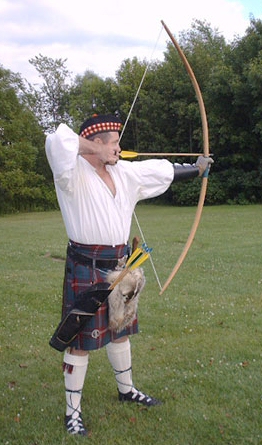
The longbow
 The longbow |
The Wars of Scottish Independence were a series of military
campaigns fought between Scotland and England in the late 13th and early 14th
centuries. The First War (1296–1328) began with the English invasion of Scotland
in 1296, and ended with the signing of the Treaty of Edinburgh-Northampton in
1328. The Second War (1332–1357) began with the English supported invasion of
Edward Balliol and the 'Disinherited' in 1332, and ended around 1357 with the
signing of the Treaty of Berwick. The wars were part of a great national crisis
for Scotland and the period became one of the most defining moments in the
nation's history. At the end of both wars, Scotland still retained her status as
a free and independent nation, which was her main aim throughout the conflict.
The wars were also important for other reasons, such as the emergence of the
longbow as a key weapon in medieval warfare.
King Alexander III of Scotland passed away in 1286, leaving his three-year old
grand-daughter Margaret as his heir. Unfortunately she died 4 years later. With
her death, there were 14 rivals for succession, the two leading competitors for
the Scottish crown were Robert Bruce (grandfather of the future King Robert the
Bruce) and John Balliol. Fearing civil war between the Bruce and Balliol
families and their supporters, the Guardians of Scotland (de facto heads of
state of Scotland during Interregnums) wrote to Edward I of England, asking him
to come north and arbitrate between the claimants in order to avoid civil war.
Edward arrived with his army and definite plans to subdue Scotland. With no
King and with no army ready, the Scots had little choice, and the claimants
acknowledged Edward as their Lord Paramount. Acting as the Lord Paramount of
Scotland, Edward I ordered that on a "temporary basis" every Scottish Castle be
placed under his control and all Scottish officials were to resign their offices
and be re-appointed by him. Two days later, in Upsettlington, the Guardians and
the leading Scottish nobles gathered to swear allegiance to King Edward I as
their superior and Lord Paramount. A few months later the Scots decided to
rid themselves of the unwanted English yoke and organised themselves against
Edward first under the leadership of William Wallace then Robert Bruce (father
of the future King Robert the Bruce). In 1306 Robert Bruce became
the King of Scotland (1306 – 1329).
(For more details of the War of Independence read the entry on William Wallace.)
credits:
The text was extracted from Wikipedia The Free Encyclopedia under GNU Free Documentation Licence.